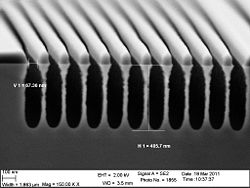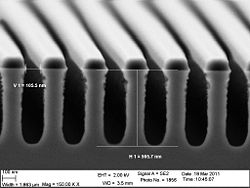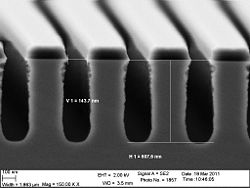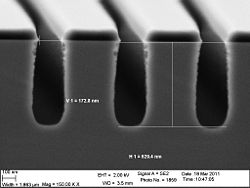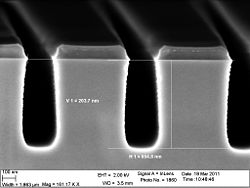Specific Process Knowledge/Etch/DRIE-Pegasus/nanoetch/nano10: Difference between revisions
| Line 48: | Line 48: | ||
== Comments == | == Comments == | ||
The process looks to be too etch aggressive, not enough passivation. | The process looks to be too etch aggressive, not enough passivation. Consider any or all of the following: | ||
* Decreasing the wafer temperature (make more passivant) | * Decreasing the wafer temperature (make more passivant) | ||
* Increasing C4F8 flow (make more passivant) | * Increasing C4F8 flow (make more passivant) | ||
Revision as of 08:39, 31 March 2011
The nano1.0 recipe
| Recipe | Gas | C4F8 38 sccm, SF6 52 sccm |
|---|---|---|
| Pressure | 4 mTorr, Strike 3 secs @ 15 mTorr | |
| Power | 800 W CP, 50 W PP | |
| Temperature | 10 degs | |
| Hardware | 100 mm Spacers | |
| Time | 120 secs | |
| Conditions | Run ID | 1801 |
| Conditioning | Sequence: Oxygen clean, MU tests, processes, no oxygen between runs | |
| Mask | 1dfhj10 nm zep etched down to 6dgh4 nm |
- The results of the nano1.0 recipe
-
The 30 nm trenches
-
The 60 nm trenches
-
The 90 nm trenches
-
The 120 nm trenches
-
The 150 nm trenches
Comments
The process looks to be too etch aggressive, not enough passivation. Consider any or all of the following:
- Decreasing the wafer temperature (make more passivant)
- Increasing C4F8 flow (make more passivant)
- Increasing platen power (make more directional)
- Decreasing coil power (make less etch-aggressive and more directional.
Also, if the tool has Short Funnel and 5mm spacers fitted, it may be too close to the plasma - previous good nano-scale etch result was achieved with Long Funnel and 100mm spacers.
The conditions are similar to the nano-etch conditions for acceptance process C:
| Etch | |
| Gas Flow (sccm) | SF6 38 + C4F8 70 |
| Pressure (mT) | 4 |
| APC angle (%) | 33.2 |
| Coil power (W) | 450 |
| Matching (Forward/ Load) | L/ 33 & T/ 43 |
| HF Platen power (W) | 100 |
| Matching (Forward/ Load) | L/ 49 & T/ 53 |
| Time | 01:30 |

